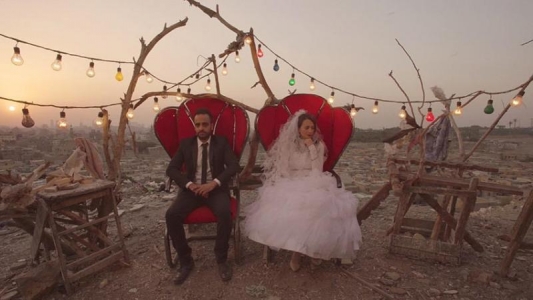Video works inspired by Arab revolts premiere in London's Aga Khan Centre 2019-11-16
LONDON - In her first solo British exhibition, “At the Corner of a Dream,” Egyptian activist Bahia Shehab voiced powerful messages on a variety of themes presented through five short videos reflecting on Arab revolts.
The videos showcased at London’s Aga Khan Centre are digital artworks produced this year. They follow on the poetry murals inspired by Palestinian poet Mahmoud Darwish that Shehab painted in Cairo, New York, Beirut and Marrakech, as well as the Greek island of Kefalonia.
Shehab began to paint poetry by Darwish on the walls of various cities in original forms of Arabic script after the Egyptian uprising (2011). “She uses lines from his poetry to tell the world that ideas cannot be killed and to show that humankind is united in its struggle against oppression and dictatorship,” the Aga Khan Centre said in a statement.
Each location in the videos corresponds to a site where Shehab created a mural.
“I view my walls as meeting points and conversation starters,” Shehab said in a statement. “By raising the curiosity of passers-by, they serve as cultural bridges, prompting them to ask about the stories behind the writing and encouraging them to stop and ask how they can tackle injustice in their own country or how they can work for equality and help others live in a better world.”
In “My Country Is Not a Suitcase,” visitors see various items being packed into a suitcase on four screens: books, fruit and vegetables, gifts and clothes. Each bag sheds light on a different trauma.
“Every time I pack my bag, I have to pack my food, my dreams and my clothes, “Shehab said. “Every time I pack my bag, I pack my heart because it is my compass. Every time I pack my bag, I pack away my tears of the people I will miss.”
“Those Who Have No Land Have No Sea” was created at a swimming pool reminiscent of one in Kefalonia where Greek Olympians trained. It depicts a macabre, yet disturbingly realistic, scene of floating life jackets accompanied by a single body. Shehab was struck by the parallels between the trainee swimmers and refugees who drowned in the sea just beyond the sports centre wall.
In “We Love Life,” Shehab reflects on Darwish’s stanza: “We love life if we have access to it.” It depicts a wedding in four settings. In the first, the couple is seen in a tuk-tuk; then they are seated in their wedding chairs on the street in front of a local butcher’s shop; later they are seen in a destroyed house and, finally, they sit on thrones with the city of the dead in the background.
The video plays on the idea of hope and the ability to dream visualising something as joyous as a wedding to reflect a very morbid reality where even hope becomes impossible.
In “Erasing Memory,” a hidden hand-paints ‘no’ on a concrete wall: No to stupidity, blood, extremism, killing, violence, hatred. The slogans are erased as soon as they appear suggesting that the hopes and dreams of the “Arab spring” were erased never to be seen again. When revolution swept through Egypt in 2011, Shehab began spray-painting the Arabic script for ‘no’ in the streets of Cairo, saying no to dictators, no to military rule and no to violence.
“Imprisoned Butterflies” compares women prisoners to butterflies stuck in ancient display cases. The cases overshadow the beauty of the butterflies just as the prison overshadows the beauty of the women who long to free themselves from the confines of its walls.
Before watching the video, visitors see a site-specific calligraphy stencil wall work and two vitrines containing paraphernalia relating to Shehab’s artistic practice.
The exhibition was commissioned by the Aga Khan University Institute for the Study of Muslim Civilisations (AKU-ISMC). It is accompanied by a book highlighting Shehab’s poetry-based work published by Gingko Press in association with AKU-ISMC.
Shehab’s work first came to global attention during the Egyptian revolution through her series “A Thousand Times No.”
These calligraffiti stencil works, which Shehab applied to walls across Cairo with spray paint, were inspired by the Arabic saying, “No and thousand times no.”
Her stencil drawings included a representation of a bra, rendered in blue paint, which was inspired by the public stripping of an unidentified woman on the streets of Cairo, in which her abaya was removed by soldiers, revealing her undergarments.
“At the Corner of a Dream” will be at the Aga Khan Centre in London through January 5.
- 3435 reads
 Ismaili.NET - Heritage F.I.E.L.D.
Ismaili.NET - Heritage F.I.E.L.D.